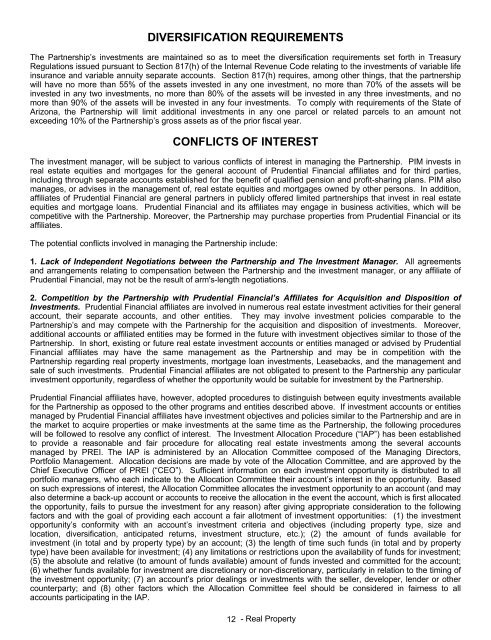The Prudential Series Fund
The Prudential Series Fund
The Prudential Series Fund
Create successful ePaper yourself
Turn your PDF publications into a flip-book with our unique Google optimized e-Paper software.
DIVERSIFICATION REQUIREMENTS<br />
<strong>The</strong> Partnership’s investments are maintained so as to meet the diversification requirements set forth in Treasury<br />
Regulations issued pursuant to Section 817(h) of the Internal Revenue Code relating to the investments of variable life<br />
insurance and variable annuity separate accounts. Section 817(h) requires, among other things, that the partnership<br />
will have no more than 55% of the assets invested in any one investment, no more than 70% of the assets will be<br />
invested in any two investments, no more than 80% of the assets will be invested in any three investments, and no<br />
more than 90% of the assets will be invested in any four investments. To comply with requirements of the State of<br />
Arizona, the Partnership will limit additional investments in any one parcel or related parcels to an amount not<br />
exceeding 10% of the Partnership’s gross assets as of the prior fiscal year.<br />
CONFLICTS OF INTEREST<br />
<strong>The</strong> investment manager, will be subject to various conflicts of interest in managing the Partnership. PIM invests in<br />
real estate equities and mortgages for the general account of <strong>Prudential</strong> Financial affiliates and for third parties,<br />
including through separate accounts established for the benefit of qualified pension and profit-sharing plans. PIM also<br />
manages, or advises in the management of, real estate equities and mortgages owned by other persons. In addition,<br />
affiliates of <strong>Prudential</strong> Financial are general partners in publicly offered limited partnerships that invest in real estate<br />
equities and mortgage loans. <strong>Prudential</strong> Financial and its affiliates may engage in business activities, which will be<br />
competitive with the Partnership. Moreover, the Partnership may purchase properties from <strong>Prudential</strong> Financial or its<br />
affiliates.<br />
<strong>The</strong> potential conflicts involved in managing the Partnership include:<br />
1. Lack of Independent Negotiations between the Partnership and <strong>The</strong> Investment Manager. All agreements<br />
and arrangements relating to compensation between the Partnership and the investment manager, or any affiliate of<br />
<strong>Prudential</strong> Financial, may not be the result of arm's-length negotiations.<br />
2. Competition by the Partnership with <strong>Prudential</strong> Financial’s Affiliates for Acquisition and Disposition of<br />
Investments. <strong>Prudential</strong> Financial affiliates are involved in numerous real estate investment activities for their general<br />
account, their separate accounts, and other entities. <strong>The</strong>y may involve investment policies comparable to the<br />
Partnership’s and may compete with the Partnership for the acquisition and disposition of investments. Moreover,<br />
additional accounts or affiliated entities may be formed in the future with investment objectives similar to those of the<br />
Partnership. In short, existing or future real estate investment accounts or entities managed or advised by <strong>Prudential</strong><br />
Financial affiliates may have the same management as the Partnership and may be in competition with the<br />
Partnership regarding real property investments, mortgage loan investments, Leasebacks, and the management and<br />
sale of such investments. <strong>Prudential</strong> Financial affiliates are not obligated to present to the Partnership any particular<br />
investment opportunity, regardless of whether the opportunity would be suitable for investment by the Partnership.<br />
<strong>Prudential</strong> Financial affiliates have, however, adopted procedures to distinguish between equity investments available<br />
for the Partnership as opposed to the other programs and entities described above. If investment accounts or entities<br />
managed by <strong>Prudential</strong> Financial affiliates have investment objectives and policies similar to the Partnership and are in<br />
the market to acquire properties or make investments at the same time as the Partnership, the following procedures<br />
will be followed to resolve any conflict of interest. <strong>The</strong> Investment Allocation Procedure (“IAP”) has been established<br />
to provide a reasonable and fair procedure for allocating real estate investments among the several accounts<br />
managed by PREI. <strong>The</strong> IAP is administered by an Allocation Committee composed of the Managing Directors,<br />
Portfolio Management. Allocation decisions are made by vote of the Allocation Committee, and are approved by the<br />
Chief Executive Officer of PREI (“CEO”). Sufficient information on each investment opportunity is distributed to all<br />
portfolio managers, who each indicate to the Allocation Committee their account’s interest in the opportunity. Based<br />
on such expressions of interest, the Allocation Committee allocates the investment opportunity to an account (and may<br />
also determine a back-up account or accounts to receive the allocation in the event the account, which is first allocated<br />
the opportunity, fails to pursue the investment for any reason) after giving appropriate consideration to the following<br />
factors and with the goal of providing each account a fair allotment of investment opportunities: (1) the investment<br />
opportunity’s conformity with an account’s investment criteria and objectives (including property type, size and<br />
location, diversification, anticipated returns, investment structure, etc.); (2) the amount of funds available for<br />
investment (in total and by property type) by an account; (3) the length of time such funds (in total and by property<br />
type) have been available for investment; (4) any limitations or restrictions upon the availability of funds for investment;<br />
(5) the absolute and relative (to amount of funds available) amount of funds invested and committed for the account;<br />
(6) whether funds available for investment are discretionary or non-discretionary, particularly in relation to the timing of<br />
the investment opportunity; (7) an account’s prior dealings or investments with the seller, developer, lender or other<br />
counterparty; and (8) other factors which the Allocation Committee feel should be considered in fairness to all<br />
accounts participating in the IAP.<br />
12 - Real Property
















